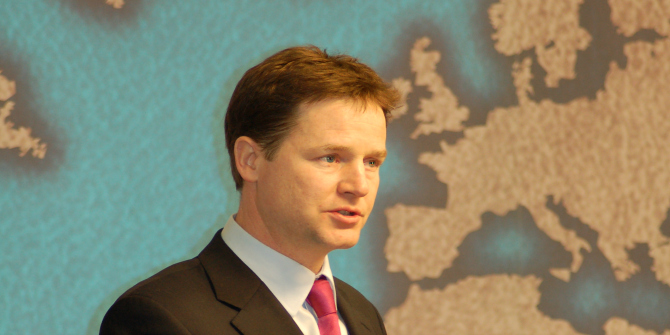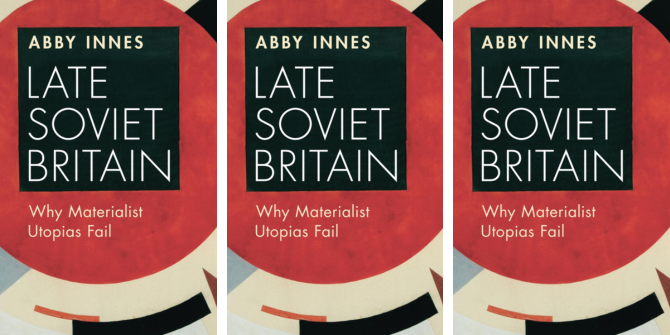In Cross-Party Politics in Britain, 1945-2019, Alan Wager surveys cross-party dynamics in British politics since the end of the Second World War through a blend of archival research and oral history. According to Richard Carr, Wager presents a compelling analysis through seven case studies of key coalitions and re-evaluates the role of the Liberal movement within the two-party system.
Cross-Party Politics in Britain, 1945-2019. Alan Wager. Oxford University Press. 2024.
 As Britain gears up for an election which, according to all polls, looks set to produce a majority Labour government, Alan Wager’s interesting new work illustrates the significant cross-party currents that have marked Westminster politics since the Second World War.
As Britain gears up for an election which, according to all polls, looks set to produce a majority Labour government, Alan Wager’s interesting new work illustrates the significant cross-party currents that have marked Westminster politics since the Second World War.
Wager’s book is built around seven case studies – stretching from Churchill’s “prolonged pursuit” (40) of the Liberal Party as a means of toppling Clement Attlee through to the Conservative-Brexit Party alliance which “Got Brexit Done,” sort of, in 2019-20. Along the way we take in, among others, Ted Heath’s attempts to scramble together an administration in 1974, the road to the Social Democratic Party (SDP), and, of course, the Cameron-Clegg coalition. Throughout, this is a strong study which ably mixes archival work and oral history. It is written in an engaging tone that is intellectually rigorous. It holds its central narrative – which, after all, has to manage jumping between case studies – very well.
The First-Past-the-Post-fuelled addiction to proclaiming a “winner” and a “loser” in each election has mitigated against cross-party working in interesting ways
Several key themes emerge. Notably, the First-Past-the-Post-fuelled addiction to proclaiming a “winner” and a “loser” in each election has mitigated against cross-party working in interesting ways. Certainly, the issue of narrative – of having “lost” in both 1974 elections, though narrowly – clearly did for Ted Heath, as it did for Gordon Brown in 2010.
Yet even winners make cross-party mistakes. In that latter election, Wager wisely notes (164), David Cameron’s failure to push for a wider political realignment was also a classic reversion to two-party politics. His real aim was to secure the hegemony of the Tories against their principal opponent, Labour, thus bolstering Nick Clegg and the Lib Dems as part of any political realignment was always going to take second place to squeezing his coalition partners – even if it then emboldened his own pro-Brexit right. The notion that Clegg was ultimately an ally worth defending, certainly compared to Bill Cash, was never given serious enough thought. Tribalism essentially won out – a perennial theme.
David Cameron’s failure to push for a wider political realignment was also a classic reversion to two-party politics.
Cameron included, the role of the leaders takes centre stage throughout the book. The 1977-78 Lib-Lab agreement to sustain Jim Callaghan’s administration was, in reality, more of a “Callaghan-Steel pact” – even in the analysis of its Liberal signatory – than it was a genuine attempt to carry the two parties into anything even approaching ideological homogeneity. Steel subsequently actively discouraged Roy Jenkins from joining the Liberals, paving the way for a separate SDP – even if one soon seeking to pursue an electoral alliance. Fast-forward a little over a decade and Tony Blair’s role as both a pluralist and a control freak – driving through radical constitutional changes such as devolution to Scotland and Wales, a Freedom of Information Act, and significant re-calibration of the House of Lords, all of which had been largely scoped out by his predecessor John Smith – comes across vividly. So too does his differing strategic ends to Ashdown – with the New Labour leader seeking to “gobble up” the Lib Dems, rather than gift them electoral reform (115).
Large parties want to maintain the status quo, and smaller ones want to disrupt it. Cross-party working is often just an avatar in that ever-dominant process.
In a sense, this speaks to a broad theme of the work: that large parties want to maintain the status quo, and smaller ones want to disrupt it. Cross-party working is often just an avatar in that ever-dominant process. This does not preclude sometime co-operation – Steel and Clegg both could claim having got “something” on electoral reform to their parties at the start of their deals, even if neither arrangement delivered the goods in practice – but it does often make it more difficult.
Overall, this is an important contribution to the literature that made me re-think a number of assumptions about post-war British politics. It is not a work of counterfactual history, though inevitably will provoke musings in that direction – rather like Colm Murphy’s recent Futures of Socialism.
This is a matter of personal taste, but I wondered if other case studies could have usefully extended the work. Since the book ends on Brexit – and on both the People’s Vote and Farage wings of politics – an analysis of the origins of the European Movement or, as Robert Saunders has persuasively done, the 1975 Referendum campaign with its various cross-party alliances, may have added much. Equally, the way socially liberal reforms like abortion were managed through Private Members’ Bills brought forward by Liberals but ultimately delivered by Wilson’s Labour government may also have plugged the chronological gap between Churchill and Heath somewhat. Alwyn Turner’s “Blajorism” – with its consensual approach to public service reform (certainly with greater New Labour money), post-Dunblane banning of handguns, and particularly the road to the Good Friday Agreement in Northern Ireland – may have offered an interesting Conservative-Labour way into the themes of the work, though links were clearly different and often mediated through the civil service, and governmental transition – itself an interesting area. Such examples may have bolstered an already excellent analysis.
This work forms an interesting way to re-evaluate the position of the Liberal Party/Liberal Democrats.
As it is, the book’s cover image shows a determined David Cameron sitting next to a rather sheepish Nick Clegg. In a significant sense, this work forms an interesting way to re-evaluate the position of the Liberal Party/Liberal Democrats. As Ed Davey towels himself off after whatever theme park slide he next undertakes as part of the ongoing election campaign, it would really be worth a read for him and his team. Among many astute points this work (140) highlights that the pursuit of political equidistance between the Conservatives and Labour had been an ongoing feature of the Kennedy-Campbell-Clegg Lib Dem leadership continuum in the 2000s – the electorate simply hadn’t noticed, or ascribed it to one off disagreements over the future of the voting system or the Iraq War.
As such, the breathless shock that surrounded the negotiation of the new administration in May 2010 was in part the novelty of post-war coalition, but also represented the failure of political journalism to hammer home that two public school southern English leaders of a similar age, socially liberal disposition, and who had worked together on issues like the Gurkhas could actually translate that into something more concrete. Latterly, when Nick Clegg (196) saw photos of himself sitting next to Cameron at PMQs he experienced something of a personal revelation akin to the end of Animal Farm.
This is an insightful, readable and clear study of recent decades in Westminster. […] Whether we see any imminent new flowerings of its central messages of course will depend on events on 4 July
All in all, this is an insightful, readable and clear study of recent decades in Westminster. Undergraduate courses on British party politics would benefit from its findings, as would political journalists and party members. Whether we see any imminent new flowerings of its central messages of course will depend on events on 4 July. But the question of how long and how far the “complicated, fragmented, and increasingly volatile British electorate” continue to buy the “artificial construction” of the “two-party system” (202) is unlikely to go away altogether.
Note: This review gives the views of the author, and not the position of the LSE Review of Books blog, nor of the London School of Economics and Political Science.
Image credit: David Cameron and Nick Clegg waving outside No 10 Downing Street in May 2010, courtesy of Number 10 on Flickr License: CC BY-NC-ND 2.0.







